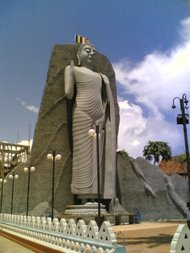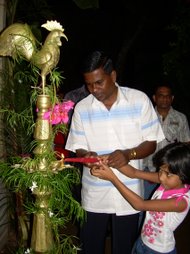Colombo-Kandy: From footpath to expressway
- JP
 In 1972, Ceylon Observer Features Editor Eustace Rulach satirised Sri Lanka’s road and transport system in an article titled, `Tourist Ceylon in the year 2072.’ It is about a group of foreigners travelling from Colombo by tourist coach to the Katunayake airport. Two hours later, the tired and shaken passengers clamber off the coaches. One elderly tourist tells another, “I heard my grandpa talk about this trip to the airport from the city, and that it took longer than the flight to Bangkok. My God! That was eighty years ago, and I thought he was joking!”
In 1972, Ceylon Observer Features Editor Eustace Rulach satirised Sri Lanka’s road and transport system in an article titled, `Tourist Ceylon in the year 2072.’ It is about a group of foreigners travelling from Colombo by tourist coach to the Katunayake airport. Two hours later, the tired and shaken passengers clamber off the coaches. One elderly tourist tells another, “I heard my grandpa talk about this trip to the airport from the city, and that it took longer than the flight to Bangkok. My God! That was eighty years ago, and I thought he was joking!”
Our road conditions are not far different today from what they were in 1972 owing to the increasing volume of vehicular traffic. Sri Lanka’s annual loss due to faulty road systems is around Rs.200 billion, according to a survey that the Moratuwa University conducted a few years ago. Needless to say this problem will continue until the planned network of expressways linking the country’s major towns and cities are completed.
How did our grand parents and their elders cope with such situations? To begin with they did not face the transport difficulties we face today. There were four very good reasons for this: (1) life moved at a much lower pace and people travelled less (2) an excellent railway system that was almost never hampered by work stoppages or strikes (3) there was far less vehicular traffic on the highways and (4) towns were much less congested. In the very early part of the last Century, the Galle-Colombo road - say from Moratuwa to Pettah - was half the width of what the same stretch is today.
There were no motor vehicles in Sri Lanka and most parts of the world until the beginning of the 20th Century since the first petrol-driven automobile was invented only in1885. Although the Dutch (1658-1796) constructed a network of roads encircling the island’s coastal belt this country’s most important road - the Colombo-Kandy highway - was built only after the Kandyan Kingdom fell to the British.
But around 2000 years ago at the peak of the ancient Sinhala civilisation our kings did construct some excellent roads and mileposts some of which were discovered in Anuradhapura and Polonnaruwa. These however were built long before Sri Lanka’s encounter with the Western powers and the subsequent establishment of the Kandyan kingdom.
Following the European occupation of the Maritime Provinces the Kandyan Kings did not allow the building of any roadways linking the hill country with the low lands for a very good reason. The non-existence of a road network made it extremely difficult for the foreign forces occupying the coastal areas to reach the hill capital. The jungle bordering the kingdom was kept thick and only footpaths were allowed to penetrate it.
This environment was ideal for waging guerilla warfare against any invader. The policy made good dividends in an age when ox caravans, horse-back and palanquins were the principle means of transport.
At the time it took as long as 10 days to reach Kandy along the cart-track-cum-foot path from Colombo whereas today it is a matter of two-and-a-half-hour journey by motor vehicle or train.
When the British decided to open up the jungle and build a roadway it was primarily for military purposes rather than for public use. Later with the dawn of the coffee era the road began to serve commercial objectives as well.
The credit for the construction of the Colombo-Kandy road goes to Governor Sir Edward Barnes who assumed office in 1820. While the first sod was cut in 1820 and the trail was completed in 1821, the road was not open to traffic until 1825. Even then it had a few culverts and bridges that were not completed until 1833 and the metalling was not begun until 1841.
Contract labour was employed to build the part of the road which went through the low country. This work was under the direction of Captain Frazer who was noted for his lurid language. When complaints were made against him Governor Barnes responded by saying that Frazer was just the man for the job since it required a person who was willing to “dam the streams” and “blast the rocks.”
Another military officer, Major Skinner was appointed to build a portion of the Kandy Road from Ampitiya to Warakapola, just above the half-way mark. He noted in his diary that the natives with whom he had to work were “totally unskilled labourers who had never seen a yard of made road in the country, for the best of reasons that such a thing did not exist”.
The villagers that Skinner mentions were working under a system inherited from the Sinhala Rajakariya system, under which the tenant of a property might be required to do two-weeks work for the State. A similar system prevailed in England in the Middle-Ages. Since labour was not paid, it was necessarily inefficient. Even worse was that the whole labour force changed every two weeks and a new labour force had to be taught how to exactly set about working.
This system, which was abolished in 1832, was going on all along the Kandyroad though there was also a Corps of Pioneers recruited for the purpose. Skinner’s fellow officers were a cheerful hard-working crowd and it appears that some of them died due to excessive drinking rather than by accidents during road building.
A bigger menace was malaria - called ‘jungle fever’ in those days since its connection with the mosquito was then unknown.
Building the road to the hill country literally became an uphill task since every night wild elephants broke down the embankments. In addition marshes, quagmires, swamps, pools and puddles posed a major challenge to the engineers and workers. But completed the road was enabling travellers to get to Kandy within a day by horse-drawn carriage.
While the road was under construction in 1822 a pontoon bridge was thrown across the Kelani River to span it at Grandpass. This bridge carried all the traffic that passed the point until the Victoria Bridge was opened for traffic in 1895.
The Gordon Bridge across the Hingula Oya was completed in 1822 and a few other minor bridges too came up by 1825. Two other important bridges - one across the Maha Oya at Mawanella and the other across the Mahaweli Ganga at Peradeniya were both completed in 1832.
The latter was of course spanned by the famous Wedge Bridge comprising one single span of 250 feet. Although it was to be done entirely of satin-wood some milla was substituted for its lower ribs during the latter part of the construction due to a shortage of satin wood. However it did not reduce its value for it was a piece of master-craftsmanship.
This was designed on the instructions of Lt. General John Frazer based on the system of wedge bridges. The bridge was constructed in Colombo and on completion transported to Peradeniya where it was erected by Captain A. Brown without a single nut or bolt of any kind!
This too withstood all the traffic for 72 long years until an iron structure replaced it in 1905. A model of this satin-wood bridge was taken to be exhibited permanently in the South Kensington Museum in London.
After the Kandy Road was opened to the public, toll points (a modern day feature in developed countries) were established at the bridge of boats at Grandpass, Atulugama, Ambepussa Bridge, Anguruwella, Kadugannawa Pass and the Peradeniya Bridge.
No uniformity of rates prevailed in the early period and occasionally it led to confusion and exploitation of road users. To rectify this defect an Ordinance titled, “For establishing an uniform rate of tolls on the road from Colombo to Kandy...” was passed in 1841. These tolls were chargeable upon passengers, carts, carriages, cattle and other animals and goods.
There were also concessions to certain people enumerated in the Ordinance and the Government Agent was the proper authority to direct the toll-keepers in writing to permit cattle driven to grass, persons with agricultural implements or with seed grain to cultivate their land and school children to and fro, to pass a point.
The Colombo-Kandy Road ended the Hill Capital’s virtual isolation from the rest of the country. It also brought a new source of revenue to the Colonial Government as well as immense wealth to several hundred entrepreneurs with the opening up of land for coffee cultivation, soon afterwards.
The dawn of the motor vehicle era, saw a mixture of both old and new modes of transport on the Colombo-Kandy Road as elsewhere. These included what we today call ‘old crocks’ or vintage cars and buses with rubber (bulb) horns, long footboards and cranks (used for starting the engine), bullock carts, horse-drawn carriages and ox-drawn buggies.
Lake House was among the companies that operated a Colombo-Kandy bus service beginning in the 1920s. Horse drawn carriages continued to ply on our roads till about the late 1930s. However even in the mid 1950s I remember seeing as a child a few pony-drawn carriages in the Anuradhapura town.
The length of the island’s road network today is about 92700 km. The roads linking the provinces belong to the A class while those connecting the districts belong to B class. These roads are 11600 km in total length. The roads belong to the C, D and E categories are 16500 km long and unclassified roads are 64000 km.
New challenges - however - are bound to occur with the completion of expressways. . The problem however is that neither the police nor the emergency rescue services, pedestrians’ and local residents, are aware of road safety issues linked to super highways of this type.
According to Romesh Fernando, a one-time public awareness specialist at a Swedish consultancy firm, such expressways will require new facilities such as emergency phones at regular intervals to alert traffic police and emergency services. New regulations, he states, would also be necessary to facilitate the use of seat belts, speed control in designated lanes and the halting of vehicles.





















































No comments:
Post a Comment